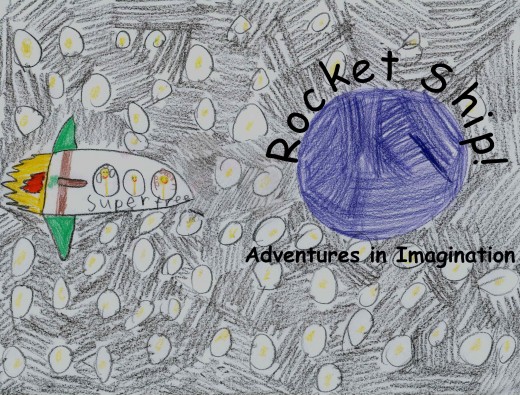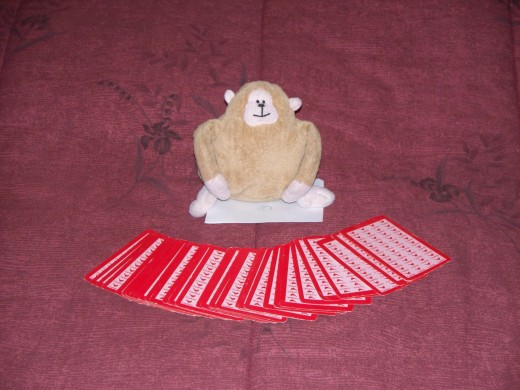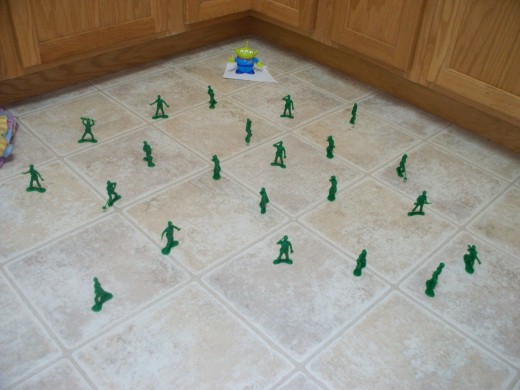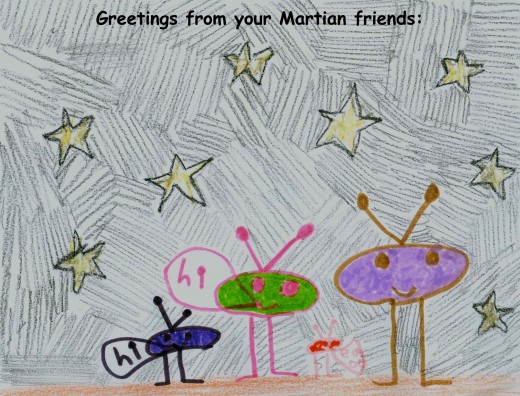Imaginative Family Fun for Kids, Free!
"Houston? Yes, come in, Houston," said the captain.
"This here's mission control," came Houston's voice through the scratchy intercom. "What can I do for ya?"
"We are ready for launch en route to Alpha Centauri. Are we clear?"
"Ready to launch, are ya? Well, we can do that. Yer gonna need a count down, though."
The captain sighs. "I don't suppose you've been working on your counting since last time?"
"What?" said Houston, insulted. "That business gettin' from four back to three is harder'n it looks. Don't worry. I'll take care of y'all!"...
If you're looking for wild, imaginative, and wide-open fun for your young children, you've come to the right place. Grab a plastic mixing bowl, plant it on your noggin, and read on. Stupendous adventure awaits!

Pre-Launch Briefing:
This is a step-by-step guide on how to turn the junk that's laying around your house into an off-world adventure for your young children. The basic game framework is simple: build a rocket ship, take your kids on a space mission, and get back to Earth safely. This article will provide lots of ideas to help make this easy for parents to do while promoting creative freedom for your kids, ensuring a good time is had by all.
Overview of the Mission:
- Stage One--Preparation: Building a Rocket Ship & Assembling the Mission Tool Chest (i.e. How to throw together a bunch of chairs, some sheets, and a few pillows to create lots of play options while grabbing some random toys and knick-knacks to throw in a sack.)
- Stage Two--The Launch: Assigning Roles & Learning the Launch Sequence (i.e. How to give the kids a job and simple ideas for starting the adventure.)
- Stage Three--Traversing the Stars: Chryogenic Freeze & Planetary Landing Procedures (i.e. Mini-nap time. Excellent!)
- Stage Four--Extra Terrestrial Exploration: Mission Briefing & Alien Interaction Protocols (i.e. Three simple story structures to follow that expand your child's imagination and provide hours of space-traveling fun.)
- Stage Five--The Journey Home: Re-entry Procedures (i.e. How to shut down fast when life catches up with play time.)
In addition to these ideas, there are three appendices at the end: Ideas for Alien Life Forms, the Captain's Troubleshooting Guide, and Suggested Variations.
I hope you find it useful. Now, strap up and let's start the training!
Stage 1: Preparation
Building The Rocket Ship:
- Find open floor space large enough for each person in the crew to lay down. Setting up in the corner of a room is ideal because then you only need to construct two walls.
Tip: Build around a comfortable chair; it gives the captain--that is, you--a comfortable place to sit...unless the crew mutinies.
- Surround the space with chairs or couch cushions, leaving space for a door.
- Drape sheets across the chairs to create solid walls.
- If time and space allow, it can be fun to add a cargo bay, food storage, and an air lock for the entrance--all optional, of course.
Assembling the Mission Tool Chest:
- Grab a bag--any bag--and rifle through the toy box looking for maps, wands, kaleidoscopes, play telephones, baby rattles, and anything else you can find.
Tip: More tools means more creative opportunities to solve problems later in adventure.
Mission Preparation
- If the mission you've chosen requires preparation (see Stage 4), this should be done before the game begins.
Stage 2: The Launch
Assign Roles:
- Give each child a job: Captain (usually the adult), co-pilot, chef, science officer, security officer, medic, etc.
Learning the Launch Sequence:
- Choose a Destination: pull out your star chart (sometimes a real piece of paper, but often an imaginary screen on the wall) and pick a celestial body.
- Input Coordinates: have the co-pilot put the coordinates into the navigational computer (poke the wall and say numbers).
- Request Fueling: Have someone contact Houston and request fuel. (My kids did not realize that Houston was a place, so it quickly became the man, Houston. I generally speak for Houston, and he's not very bright.)
- Count Down to Launch: Contact Houston again and request a count down. Houston always has a hard time remembering how to count down--the kids love to help him figure it out!
- Lift Off!: At "0", shake, rattle, and roll as you head for space...
Stage 3: Traversing the Stars
Chryogenic Freeze (My Personal Favorite):
- Inter-planetary travel takes a long time, so briefly explain the idea behind chryogenic freezing (making you cold so you fall asleep until you arrive).
- Everyone lays down and "freezes" for awhile, taking a mini-nap--wonderful!
Alien Landing:
- This is just like the launch--rattle around a bit as you pass through the alien atmosphere, clunking down as you hit the ground.
Stage 4: Extra Terrestrial Exploration
The trick to a fun extra terrestrial exploration is for the captain to know where the story is going. Below, I present three simple story frames that will help keep the action moving.
Tip: For those new to this kind of activity, making up details on the spot is intimidating. Good news! Young children are easy. They don't know science and they're primed to believe anything: a pencil can become a missile, a key, or a very thin alien creature. Wing it at first. It will get easier quickly.
Basic Story Outlines:
- Exploration Mission (no pre-planning): Take your crew and wander around the house imagining an alien landscape: passing beneath the table becomes a tunnel, the stairs become a mountain, and the bathroom becomes a cave. Along the way, pull out tools from the Mission Tool Chest and invent uses for them while collecting specimens of interesting alien artifacts. "Living" aliens (stuffed animals) are especially exciting finds.
Tip: If you have a bit of time, this can be made more interesting by setting up some areas of the house ahead of time: throwing cushions on the floor in a heap, hiding stuffed animals around the house, etc.

- The Rescue Mission (minimal pre-planning): Choose a stuffed animal. This animal has been abducted by aliens. Your crew must find it, retrieve it, and bring it back home. Place the animal in some kind of "prison" (chairs do nicely) and then set up other toys and stuffed animals as "guards". Kids have great fun using the Mission Tool Chest to sneak around or defeat the bad guys. It can be fun for members of the crew to get captured as well.
Tip: We often choose one stuffed animal to serve as the bad guy "boss." Special challenges have to be met to defeat him. Card games and board games are great for this (see the photo above of the High Captain Blahr).

- Puzzle Mission (pre-planning required): While this mission requires planning, it is often the most fun. This one involves placing various stuffed animals throughout the house and creating a series of clues for each of them that lead to the next animal or location (the captions on the pictures to the right are clues I've used before). Eventually, the clues lead to a fantastical treasure or creature that the children can collect and take home. It takes time, but it's crazy fun.
Tip: Mission types can be combined in various ways once you become comfortable with them. Get creative and have a good time!
Keeping these simple story arcs in mind will keep your playtime moving, and it gets much easier with practice.
Stage 5: The Journey Home
I don't know how it will go for you, but by the time the mission begins its return to Earth, we're always late to somewhere else, so it needs to happen quickly. Here's a simple run-down:
- Get back to the ship
- Take off
- Consider skipping the chryogenic freeze
- Re-enter Earth's atmosphere
- Exit the ship: Game Over
Conclusion:
While there's a lot presented here, this is all just basic ideas to fill the framework of imaginative play. The important thing is to dive in and go, encourage your children's creativity, and let them lead as much as possible. You will find that your stories quickly begin to follow your kids' unique interests, and the world is in their hands when they enter this land of make believe. Let go and take the journey with them!

Appendix 1: Ideas for Alien Life Forms:
- Mercurian Pygmy Fire-breathing Elephant (watch out for their sneezes!)
- Venutian Fuzzy Wumps (cotton balls that like to jump all over people)
- The Martian Trio: Eeep-Op-Merr, Icky-Icky-Icky-Slurrp, and Bob (Yes, just Bob)
- The Titanian Fish Wibbles (on Jupiter's moon Titus for a watery adventure)
- Plutonian Wooly Dragon (they look fierce in their fur, but they're actually warm and fuzzy)
- Anything else you can come up with!
Appendix 2: The Captain's Trouble-Shooting Guide:
-
Problem 1: Hey, my kid's not following the script!
Keep in mind that young children will eventually begin to take some ownership of the story. While this can throw a wrench into the arc of your planned story, it's actually a good thing! Witness imagination budding; embrace it and follow their lead.
-
You do know that three-year-olds don't follow directions very well, don't you?
Yes, I do. My three-year-old regularly ran out into deep space, ignored warnings, brought in random toys, and walked right into the bad guy's lair without a second thought. What's the solution? The Space Monkey. Yes, my son became our resident space monkey. The essence of the space monkey's job is to do random things that none of the rest of us understand. We laugh, he smiles, and all is good with the world.
Links to other good hubs with useful information on imagination & chidren:
- Learning Games and Activities For Toddlers
Amy Jane presents an extensive collection of imaginative games and activities for toddlers here, categorized by age level. - Imaginative Play for Toddlers
Joy M provides a nice overview of the historical background and research related to the importance of developing imagination in children.
Appendix 3: Variations:
The Magical Mystery Train
- If outer space exploration gets old or doesn't fit your children's interests, try the Magical Mystery Train. Instead of a rocket ship, build a train. This way you can explore all over the world--Egypt, Under the Sea, The Great Wall of China, or The Enchanted Forest. Go anywhere they want to go.
Pirate Ship
- For seafaring adventurers. Once again, it's the same basic concept dressed in different clothes.





